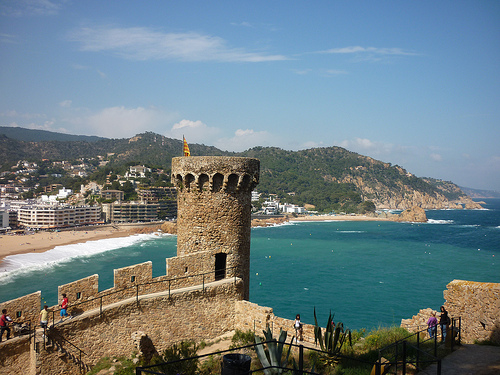Tossa de Mar is a well-known tourist resort renowned for its beaches and makes an ideal destination for anyone looking for the conveniences offered by a major resort but demanding a little more than the soulless high rise accommodation in some resorts.
With a mediaeval old town, Tossa remains extremely picturesque and it despite being one of the first towns on the Costa Brava to be developed for mass tourism in the 1950s it is still able to offer a relaxed charm.

The beach at Tossa de Mar. Photo by Freebird.
The sandy beaches are great for sunbathing, although can get a little overcrowded in the peak weeks during July and August. Nearby there are also lots of rocky coves set below the pine landscape so typical of this part of the Costa Brava, and excellent for exploring the underwater world with a facemask and snorkel.
However, there is much more to Tossa than simply beaches and water sports.
Tossa’s mediaeval origins
The mediaeval turrets and stone walls of the old town – the “vila vella” – are some of the most recognisable on the entire Costa Brava and certainly among the most photographed.
Until the 1950s the town survived on agriculture, mainly grapes and cork, for which there was much demand in the New World during the 18th and early 19th centuries. When those crops failed the town was able to fall back on fishing, but the vineyards and most cork trees are long gone, leaving only a small fishing industry remaining.
And while the arrival of mass tourism in the 1950s changed the nature of the town forever, the main village remains full of character.
Last fortified mediaeval town on the Catalan coast

Tossa de Mar old town. Photo by Albert Torelló.
In fact the vila vella is unique in being the only fortified mediaeval town remaining on the Catalan coast.
The old town is completely encircled by a battlement topped stone wall that was first constructed at some point during the 12th century and a castle built on the highest point of Mount Guardí, which was subsequently replaced by a windmill, followed by the lighthouse that remains today.
Into the wall are built seven watchtowers, four of them square and three circular, and two gates allow access and it proved particularly valuable to at defending the town against pirate attacks during the 17th century.
Although the defences began to crumble in the 19th century restoration works carried out on a number of occasions starting in 1923 have ensured the walls remain intact and in good condition and it is well worth an explore.
Expansion beyond the walls
By the 15th century there were around 80 houses within the city walls but population growth mean that the town needed to expand.
The first houses outside the walls were constructed at this time, which began to reshape the urban landscape, something that accelerated particularly during the 17th and 18th centuries to create a town that remained largely unchanged until the arrival of mass tourism in the 1950s.
While most visitors to the town choose to spend their days on the beach and never set foot inside the walls it is difficult to imagine why; a visit to the old town is provides spectacular views in addition to a glimpse of the town as it existed in previous centuries as you walk through the narrow, winding streets where you’ll find a number of cafes and restaurants.
Hollywood comes to the Costa Brava
Within the walls is a statue of Ava Gardner, who stayed on the Costa Brava in 1950 while filming “Pandora and the Flying Dutchman” with James Mason.
The story concerns a nightclub singer who is irresistible to men but unable to fall in love. Many of the scenes were shot on location in Tossa, including the beach of La Mar Menuda and Gardner was visited during the shoot by Frank Sinatra, whom she was to marry the following year.
The film was released immediately after “Show Boat”, the film that established Gardner as a star, and proved to be a success. The statue was erected in 1998 to celebrate the town’s link to the actress.
The vila vella at night

The vila vella at night. Photo by dynamosquito.
At night the walls are illuminated providing a spectacular view from the promenade.
There are sometimes concerts held at the ruins of the gothic church, Església Vella de Sant Vicenç; check local advertising to find out what is going on when.

